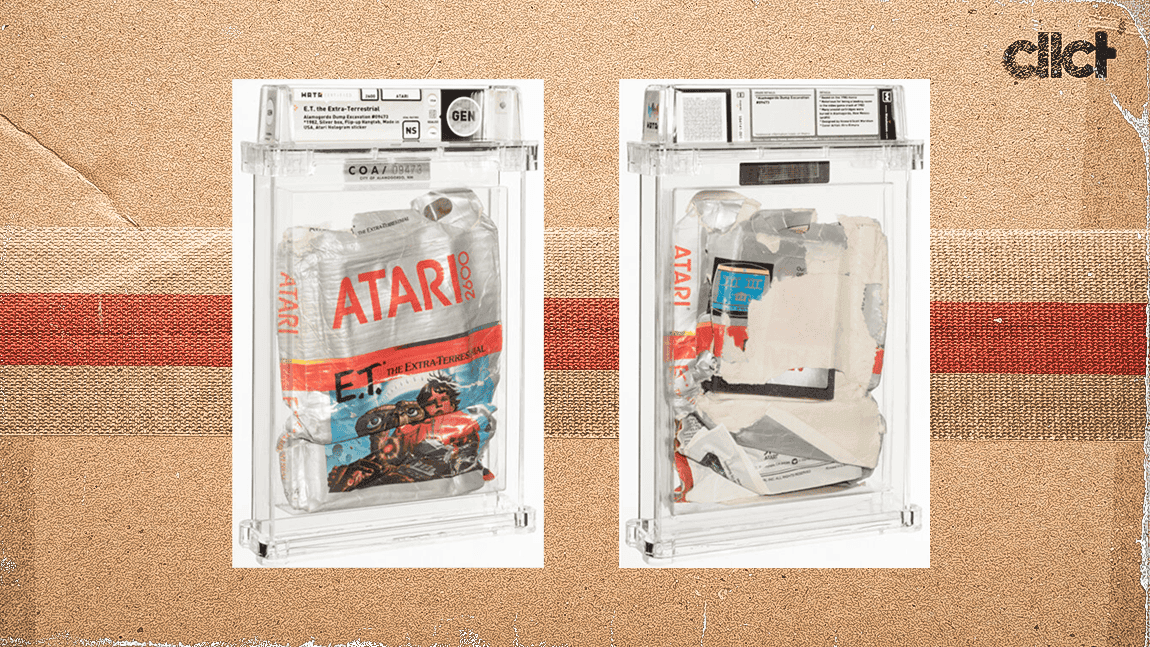Most collectors know the legend of the 1952 Topps set being dumped into the Atlantic Ocean, resulting in high-numbered cards — most notably the coveted Mickey Mantle card — becoming increasingly scarce.
But there’s another collectibles story involving the destruction of perfectly good inventory that gets far less attention. Why? Because it involved arguably the worst video game ever created.
Back in the early days of home-gaming, it was an all-out arms race, with companies such as Atari, Intellivision and ColecoVision battling for market share.
The result was a high-octane pace of new releases, with consoles (and games) arriving to market at breakneck speeds, cannibalizing previous generations in an attempt to win over gamers.
It’s hard to imagine these days, considering leading console developers such as Microsoft and Sony have settled into a regular, five- to six-year cadence between the release of next-gen consoles (Xbox and PlayStation), but the early 1980s abided by no such convention.
In 1982, Atari — purchased in 1976 for $28 million by Warner Communications — had grown into a $2 billion behemoth, the fastest-growing company in the country. Around that time, Atari owned around 80% of the video game market, in large part thanks so smash-hits such as Pong and Pac-Man.
New entrants were predicted to saturate the market. Activision president James Levy told the New York Times in June 1982 that the number of games were poised to double, with the increased competition eating into profit.
By the end of the year, Atari reported a 10-15% increase in projected earnings, a far cry from the 50% number expected. The next day, Warner’s stock tumbled 33 percent, rounding out the quarter with profits down over 50%. In 1983, Atari lost more than $530 million. The next year, Warner sold the company.
This failure can be chalked up to a number of missteps, including a poorly reviewed launch of its Atari 5200 console, licensing issues and a loss of top programming talent, in addition to the competition mentioned above.
However, Atari managed to go from the top dog to sinking ship, one incident would forever cement itself in video game lore and become the scapegoat for the entire market crash of video games.
Atari paid $21 million for the rights to produce a game for Steven Spielberg’s blockbuster “E.T.: the Extra Terrestrial.” Atari had made out OK with a prior Spielberg adaptation, “Raiders of the Lost Ark,” and clearly wanted to double-down.
Problems emerged from the very beginning. The deal was inked in July 1982, with expectations of a finished product in just five weeks, so it would be able to reach retail shelves by Christmas. The standard development process was more like six months at the time.
Atari budgeted $5 million for what would have been the biggest-ever advertising campaign for a video game with the understanding the company would need to sell 4 million copies just to break even.
The game was an unmitigated flop.
Gamers complained of frustration as the E.T. character would constantly fall into pits, resulting in sub-optimal gameplay, to put it nicely. News spread quickly and less than 40% of Atari’s inventory was sold.
Much like the solution pursued by the team at Topps in the 1950s, Atari decided to wipe its hands of the remaining inventory. But, rather than dump into the ocean, a landfill in Alamogordo, New Mexico, was chosen. Fourteen truckloads of game cartridges (many of them “E.T.”) and other equipment were deposited into the landfill in September 1983, followed by a layer of concrete for good measure.
Though reported in the New York Times at the time, the incident remained a matter of legend for decades. That is, until a documentary crew decided to dig it up in 2014. While some were disappointed, considering legend had grown to say millions of games resided within the concrete tomb, it was revealed 728,000 cartridges were initially buried. The excavation uncovered 1,300, including multiple copies of “E.T.”
Soon after, the city of Alamogordo auctioned off a lot of hundreds of the games from the find on eBay, netting more than $100,000. The top bid came in for a copy of “E.T.” which sold for $1,535.
In an unexpected turn of events, these games — once cast aside, intended for the trash bin of history — have found somewhat of a renaissance among collectors, because of, rather than despite, their brutal condition.
These unsealed cartridges have since been authenticated in many cases by companies like Wata, which designates them as originating from the landfill.
A tattered, nearly-crushed copy sold at Heritage for $2,640.
Will Stern is a reporter and editor for cllct.

